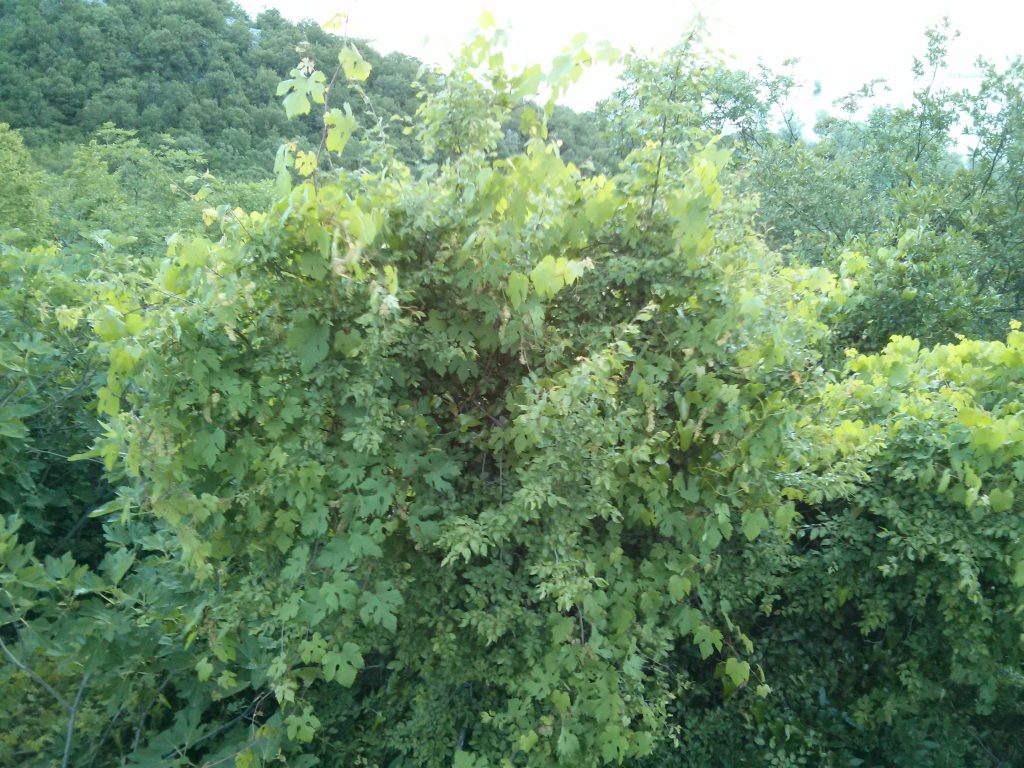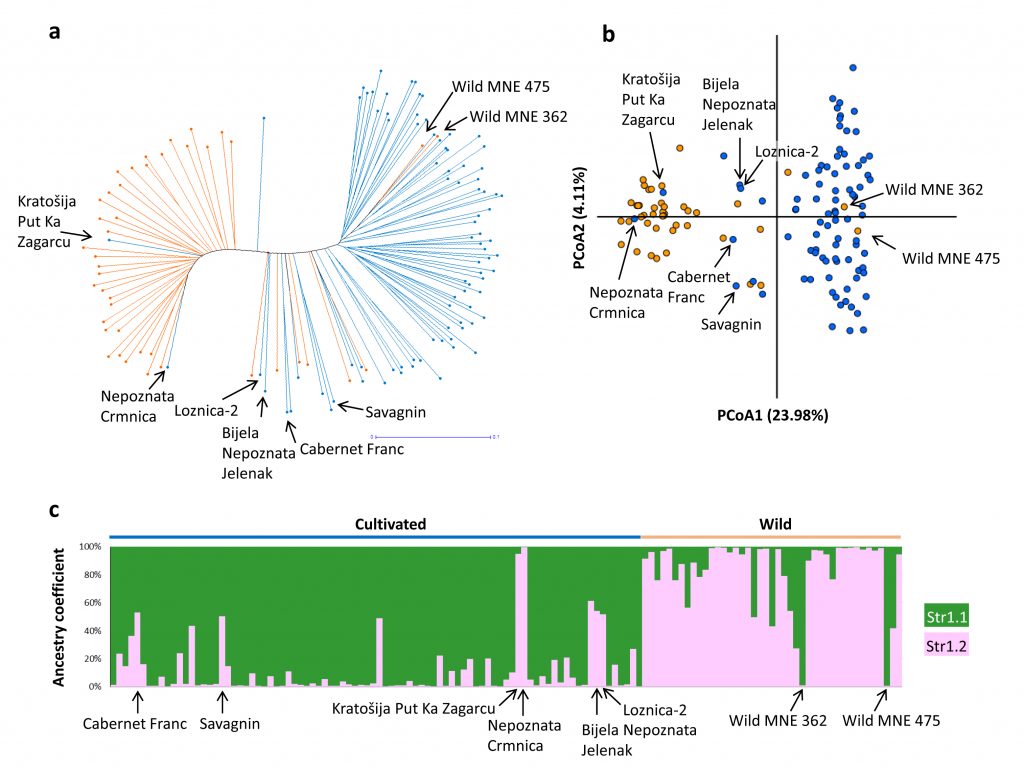By Javier Ibáñez and José Miguel Martínez Zapater
Domestication is the process of selection driven by humans that transformed wild forms into domesticated crops modifying morphological and genetic traits. The domestication process in the grapevine (Vitis vinifera L.) began in Transcaucasia 8000 years ago, during the Neolithic Age, and gave place to the appearance of the subspecies sativa or vinifera (V.v. ssp. vinifera) from the wild subspecies (V.v. ssp. sylvestris). This process probably took place along thousands of years, starting with exploited wild individuals, then early domesticated and intermediate vines and finally fully cultivated populations, with a continuum of all those vine populations during early stages, where the frequency of the formers was diminishing and of the latter was rising along time. Thus, no representatives of exploited wild individuals were currently expected but, in a recent work we found in Montenegro vines of the subspecies sylvestris being cultivated in orchards, which could be considered as proto-varieties and may represent novel active domestication events [1].

During domestication of grapevine, some traits were selected by humans, producing morphological changes that affected, for instance, the flower sex (from male and female plants to hermaphrodite vines), sugar content (raised), and berry size (increased). Other traits, like seed morphology, were affected from automatic selection, not on purpose. Thus, hermaphrodite, self-pollinating plants were selected because they have improved fruit set and are more productive, compared to female plants, which in addition need some male vine (non-productive) nearby. These selected traits were fixed through the vegetative multiplication, giving place to the varieties, all considered as belonging to the subspecies vinifera. However, in most cases, those changes were not absolute, and there are varieties that maintain the ‘sylvestris’ character for some traits. Thus, there are still female varieties, varieties with small berry size, or with open petiolar sinus in the leaves. This makes very difficult to assign a vine to the sylvestris subspecies based only on morphological traits. Fortunately, the use of DNA markers and genetic structure analyses provide decisive information on whether a vine belongs to one or the other subspecies, or it is an intermediate case.
Domesticated grapevines were disseminated from their primary domestication sites in the Near East along the Mediterranean basin, from East to West, in a process that lasted over 5000 years. Using the chloroplast genome, which is maternally transmitted, we found some of the first evidences of ‘secondary’ domestications that accompanied that spreading route, as many varieties of Western Europe bear the same chloroplast type than the sylvestris of the same region, which is different from the chloroplast genome types of the Near East [2].
In Montenegro, modern viticulture coexists with traditional viticulture that still maintains ancient practices and exploits local cultivars. As a result, this region provides a unique opportunity to explore processes that increase genetic diversity. To assess the diversity of Montenegrin vines and the processes involved in their diversification, an international multidisciplinary team led by researchers from the ICVV and the 13 Jul Plantaze winery collected 419 samples in situ throughout the country, which included both ancient plants grown in old orchards and vines that grew wild in nature, supposedly of the subspecies sylvestris. Also included in the study were 57 local varieties conserved in a vine collection. The DNAs of each of the sampled plants were subsequently analysed in the ICVV and compared with our SNP database, unique in the world for its dimensions. A total of 144 different genetic profiles were obtained, which were subjected to genetic structure analysis. Surprisingly, these analyses revealed several putative proto-varieties, forms close to sylvestris on the way to becoming cultivated varieties.

In this study, a couple of old cultivated vines sampled in orchards resulted to be plants fully belonging to the sylvestris subspecies. Each of these two vines represents first stages of the domestication process, where very probably a person took cuttings from a sylvestris plant of their interest and put them into cultivation. These proto-varieties will become varieties if they are further multiplied vegetatively and cultivated.
In addition, vines whose genetic composition is intermediate between sylvestris and vinifera were also found. In some cases, this condition was determined in samples taken in the wild (supposed to be sylvestris), while in other cases the intermediate condition appeared in the material collected as cultivated, in vineyards and orchards (vinifera), indicating that there is still genetic flow between the subspecies. The existence of genetically intermediate forms between the vinifera and sylvestris subspecies have been found in other different places, like Italy or Portugal. We recently found examples of both types in Portugal, so intermediate wild vines, what represents a threaten for the sylvestris subspecies, in danger of extinction in many regions, as varieties with a predominant sylvestris component, concretely Barcelo, Branjo, Melhorio, and Amaral [3]. The most interesting is Amaral, which clusters with wild plants in all analyses and has several descendants among Portuguese varieties.
Although it is not a variety native to Montenegro, a very interesting case of intermediate genetic constitution between sylvestris and vinifera also observed in that study is the well-known Savagnin variety, widely spread throughout Europe, including Spain. Savagnin is a progenitor of many important varieties like Pinot Noir or Sauvignon blanc, and many in the Iberian Peninsula, such as Alfrocheiro, Gouveio or Verdejo Blanco. Palaeogenomic studies have recently shown that Savagnin has been cultivated for at least 900 years [4].
All these findings represent vestiges of different initial steps in the generation of new varieties, from the direct cultivation of sylvestris individuals to early domesticated and intermediate vines resulting from natural crosses between vinifera and/or sylvestris plants and/or intermediate plants. It is very probable that, in the region where grapevine domestication started, more of these missing links between sylvestris and sativa can be found in the future, but some of the mentioned cases may well represent evidences of secondary events of domestication of the wild vine.
Picture from the cover in: https://www.biooekonomie-bw.de/application/files/cache/thumbnails/c1207fff7e67a3c905bf61111c52b4b8.jpg

Javier Ibáñez 
José Miguel Martínez Zapate 
Javier Ibáñez graduated in Biological Sciences in 1988, obtained a Bachelor’s Degree in 1990 and obtained a doctorate in Biological Sciences in 2000, all at the Complutense University of Madrid. He began working with the grapes at IMIDRA (Madrid) in 1995, in order to apply molecular analysis to the study of vine varieties. He pioneered in Spain DNA and statistical tools for varietal identification and characterization, and participated in the European networks that led this research, collaborating in the most significant works in this field. Since 2004 he also became interested in the genetic basis of natural variation for reproductive traits in grapevine, identifying the genes responsible for traits of interest in the berry and the bunch. In 2008 he combined his research activity at IMIDRA with teaching activity as Associate Professor in the Department of Genetics of the Complutense University of Madrid. In 2009 he joined the CSIC as Tenured Scientist at the Institute of Grapevine and Wine Sciences (ICVV, La Rioja), co-leading the Grapevine Genetics and Genomics research group (Vitigen) and deepening the study of the genetic diversity of the grapevine and its reproductive development. The latest projects that he has leaded have focused mainly on the characterization of the somatic variation of the vine, the genetics of the compactness of the bunch, and the genetic diversity in cultivated and sylvestris vines. In this time he has led or participated in 37 research projects and 26 contracts with regional, national and international companies. He has supervised four doctoral theses and has 102 scientific publications (56 indexed), 12 books or book chapters and 21 popularization publications related to the exposed subject. He has been a guest speaker at 30 events, contributing with 70 scientific communications in international conferences and 46 in national ones.
José Miguel Martínez Zapater is a Research Professor at the CSIC National Agency. He got a PhD in Biological Sciences from the Autonomous University of Madrid (1983) and was postdoctoral fellow at the MSU-DOE Plant Research Laboratory (East Lansing, Michigan, USA) between 1984 and 1988, funded by a Fulbright fellowship. Back in Spain, he became a researcher at the National Institute of Agricultural Research (INIA) in Madrid until 2004, when he moved to the National Research Council (CSIC). Within CSIC, he worked at the National Center for Biotechnology in Madrid from 1998 to 2009. Since 2009 he is working at the Institute of Grapevine and Wine Sciences (Joint Research Institute of the CSIC, University of La Rioja and Government of La Rioja) based in Logroño (La Rioja), where he currently is the scientific director. Along his career, he also had responsibilities as Manager of the Spanish Biotechnology Program between 1995-2000 and as Deputy General Director of Research and Technology at INIA between 2001 and 2004. His research activity has always been focused on the genetic and molecular analysis of the reproductive development of plants in both model systems (Arabidopsis thaliana) and crop species. Since 1998 his research has been directed to the study of the reproductive development of the vine and its impact on the quality of grapes and wine. With this purpose, he has also collaborated in the development of genomic tools in the vine and the study of the origin, domestication and genetic diversity of its varieties. The results of his research group has contributed to the development and characterization of new varieties and clones of grapevine and to improve current understanding of plant responses to different environmental and management conditions. Its scientific production is collected in over one hundred and fifty scientific articles, two patents and numerous technical and divulgation articles and book chapters.
References
- Maraš, V.;Tello, J.;Gazivoda, A.;Mugoša, M.;Perišić, M.;Raičević, J.;Štajner, N.;Ocete, R.;Božović, V.;Popović, T.;García‑Escudero, Enrique Grbić, M.;Martínez‑Zapater, J.M. and Ibáñez, J. Population genetic analysis in old Montenegrin vineyards reveals ancient ways currently active to generate diversity in Vitis vinifera. Sci. Rep. 2020, 10, 15000, doi:10.1038/s41598-020-71918-7.
- Arroyo-Garcia, R.;Ruiz-Garcia, L.;Bolling, L.;Ocete, R.;Lopez, M.A.;Arnold, C.;Ergul, A.;Soylemezoglu, G.;Uzun, H.I.;Cabello, F.;Ibáñez, J.;Aradhya, M.K.; […] and Martinez-Zapater, J.M. Multiple origins of cultivated grapevine (Vitis vinifera L. ssp sativa) based on chloroplast DNA polymorphisms. Mol. Ecol. 2006, 15, 3707–3714, doi:10.1111/j.1365-294X.2006.03049.x.
- Cunha, J.;Ibáñez, J.;Teixeira-Santos, M.;Brazão, J.;Fevereiro, P.;Martínez-Zapater, J.M. and Eiras‐Dias, J.E. Genetic Relationships Among Portuguese Cultivated and Wild Vitis vinifera L. Germplasm. Front. Plant Sci. 2020, 11, 27, doi:10.3389/fpls.2020.00127.
- Ramos-Madrigal, J.;Runge, A.K.W.;Bouby, L.;Lacombe, T.;Samaniego Castruita, J.A.;Adam-Blondon, A.-F.;Figueiral, I.;Hallavant, C.;Martínez-Zapater, J.M.;Schaal, C.;Töpfer, R.;Petersen, B.;Sicheritz-Pontén, T.;This, P.;Bacilieri, R.;Gilbert, M.T.P. and Wales, N. Palaeogenomic insights into the origins of French grapevine diversity. Nat. Plants 2019, 5, 595–603, doi:10.1038/s41477-019-0437-5.

